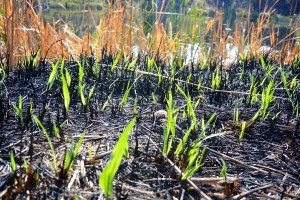Differences between fires in grasslands and forests
Conservation Northwest / Aug 08, 2018 / Sagelands, Wildfire, Work Updates
With fires burning in the shrub-steppe of Central Washington this summer, we want to highlight the different roles fire plays in grasslands and forests.
By Jay Kehne, Sagelands Program Lead
We have learned a lot about the beneficial aspects of prescribed or controlled fires in forested environments, but recent wildfires in the sagebrush country of central Washington bring up the question, “what level of fire is good in shrub-steppe habitat?” The answers are important for our Sagelands Heritage Program and other work in this part of the Northwest.
These fires often burn hot enough to kill most of the shrubs, and in wind-blown conditions they can consume thousands of acres in very short order. Once burned, sensitive shrubs like big sagebrush can take a decade to return, while bitterbrush (a plant vital for many wildlife species for winter food and cover) may not come back for a generation. Depending on the intensity of the fire, grasses like blue-bunch wheatgrass can bounce back in one or two growing seasons. Others like Idaho fescue may not return for many years if burned down to the roots.

Fire intensity in shrub-steppe depends on many factors including:
- the percent canopy coverage of shrubs,
- the height and distance between those shrubs,
- the type of grass growing below the canopy and their spatial distribution,
- and if past or current fire events have led to a heavy infestation of invasive species such as non-native cheatgrass—which causes fires to burn much hotter and faster.
We know fires have always occurred across shrub-steppe landscapes like those in central Washington, so what amount of fire is good and normal for these arid landscapes?
To answer that question we need to somehow grasp what the historical burn interval of fires pre- and post-European settlement was. This settlement across the West brought big changes to this environment including grazing of livestock. Many researchers are working on that very question and it turns out that the types of grass and shrubs in each landscape pre-settlement burned and recovered differently, leading to a variety of fire intervals and intensities.
Fire intervals ranged from as short every five years in some habitats to more than 100 years in rocky areas. This uneven pattern of burns leads to uneven aged patches of various grasses and shrubs across the landscape known as a “mosaic”. Similar patterns are also present in forests after fire. This mosaic allowed burns to occur that did not always reach large, severe or damaging proportions. In general, grasses with their crowns at ground level withstand fire better than shrubs, so fire suppression has likely allowed shrubs to increase at the expense of grasses. But the abundance of high quality shrub habitat is complicated when selective livestock grazing has changed the species mix.

Since settlement, ranchers have used some of the forage from shrub-steppe habitats for livestock. In some cases, if this grazing was not done correctly fire interval and intensity have changed, depending on whether grazing removed the fine fuels (grasses) while allowing an accumulation of woodier fuels. On the other hand, in certain cases grazing is also now being used as a tool to correct conditions that have led to increased and higher intensity fires by removing invasive plants, and or lowering total biomass through rotational grazing to affect fire intensity. Cattle are also being used to reduce fuels immediately around homes.
The key to good grazing is a plan that takes into account the life-cycle of the plants being grazed, the animals doing the grazing (whether wildlife or livestock), the timing of that grazing, allowance for rest and recovery periods, and managing consistently with natural or historical conditions. Sustainably grazed lands can maintain a diverse shrub -steppe landscape that allows for better control of wildfires.
We know that fire is a natural and often beneficial process in the dry forests of North America. And similarly, fire has long been a component of sage-steppe landscapes across the West. However, the role that fire plays here varies from dry forests due to the presence of vastly different plant life, terrain, and environments.

Some fire is to be expected in the sage-steppe, and in the right doses it can be beneficial for healthy habitat. However, where invasive plants or heavy human disturbance occur, grasslands fires can be unnaturally severe with long-lasting impacts on habitat, wildlife, and local communities.
We’re working with biologists, range managers, local residents and fire protection associations to mitigate this, and improve sage-steppe conditions for everyone who calls these arid landscapes home.
Jay Kehne has degrees in biology and soil sciences and joined Conservation Northwest after a 31-year career with the U.S. Department of Agriculture Natural Resources Conservation Service. Jay hopes to put his experience working with ranchers and farmers, combined with his love of Washington’s shrub-steppe habitat, to work helping to connect and protect important habitats for a variety of species in the arid lands of our state. You can check out his full bio here.

